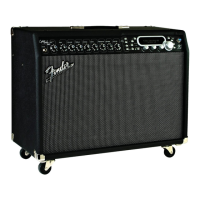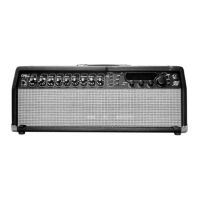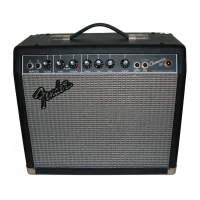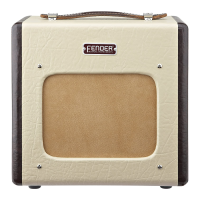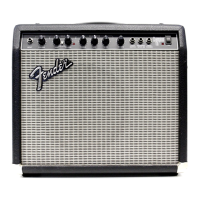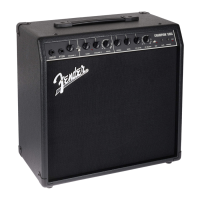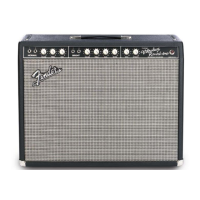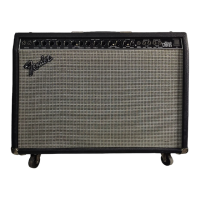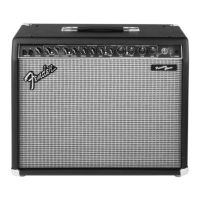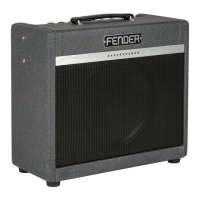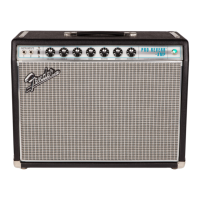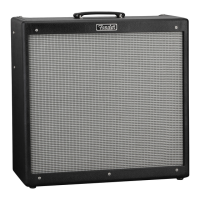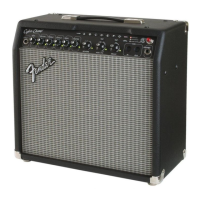
Do you have a question about the Fender CYBER-CHAMP and is the answer not in the manual?
| Type | Digital Modeling Amplifier |
|---|---|
| Weight | 18 lbs (8.2 kg) |
| Speaker Design | Fender Special Design |
| Onboard Effects | Yes |
| Inputs | 1 x 1/4" Instrument Input |
| Input Type | 1/4" Instrument |
| Speaker Size | 8 inches |
| Outputs | 1 x Headphone |
| Effects Included | Reverb, Delay, Chorus |
| Output Type | 1/4" Headphone |
| Speaker | 1x8" Fender Special Design Speaker |
Provides essential safety guidelines for unit operation, covering voltage, environment, and maintenance.
Details FCC regulations and compliance for digital device emissions and potential interference.
Highlights 21 amp designs, 14 permanent presets, and 7 user-savable presets.
Covers studio-quality effects, MIDI implementation, Virtual Tone Interpolation, and tuner.
Identifies and briefly describes the main front panel controls labeled A through O.
Explains how to select presets/banks and the process for capturing knob settings.
Details the function and use of the Input Jack, Gain, and Volume controls.
Describes the TREBLE, MIDDLE, BASS, and MASTER controls for sound shaping and output.
Explains the selection and adjustment of Reverb, Modulation (Mod F/X), and Delay effects.
Details how to use the built-in chromatic tuner and its indicator lights.
Explains preset selection buttons, bank switching, and the Hum Reduction feature.
Describes MIDI IN/OUT ports and the stereo headphone/line out jack.
Details the power switch and the connection for the AC power cord.
Defines the premium amplifier and effect combinations in the permanent Custom Shop bank.
Details the classic 'stock' amplifier presets available in the Amp Collection bank.
Describes the rewritable presets for user-created amplifier and effect setups.
Explains the process for editing and saving your own amplifier and effect configurations.
Introduces advanced effect parameter editing using a computer and MIDI.
Covers MIDI channel messages for switching tuner/effects and selecting presets.
Details how to use MIDI program changes and controller pedals for preset selection.
Lists continuous controller numbers for adjusting various amp parameters like volume and tone.
Explains MIDI control over Reverb parameters: Level, Time, Dwell, Diffusion, and Tone.
Details MIDI control for Chorus, Vibratone, Tremolo, Flange, and Phaser effects parameters.
Details MIDI control for Digital, Tape, and Ducking delay effects parameters.
Explains how to transfer presets between amplifiers and to/from a computer using SysEx.
Describes using SysEx messages to select effect types and manage Hum Reduction.
Provides a comprehensive chart of MIDI functions, messages, and their recognized parameters.
Describes the System Exclusive message components for MIDI Dump, including headers and packets.
Details SysEx message structures for selecting effect types and controlling Hum Reduction.
Explains the SysEx handshake process for data transmission between devices.
Offers solutions for common issues like no sound, MIDI response problems, or unit unresponsiveness.
Lists detailed specifications including power, impedance, speaker, dimensions, and weight.
